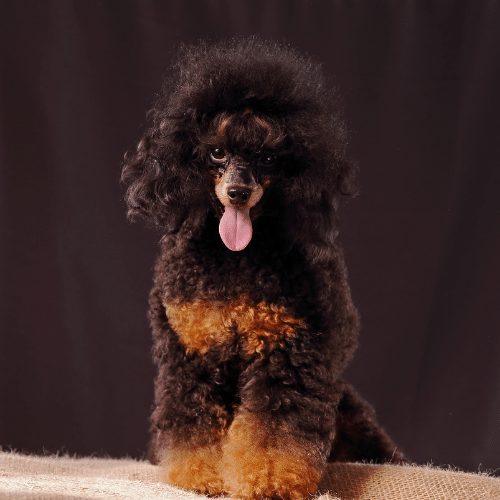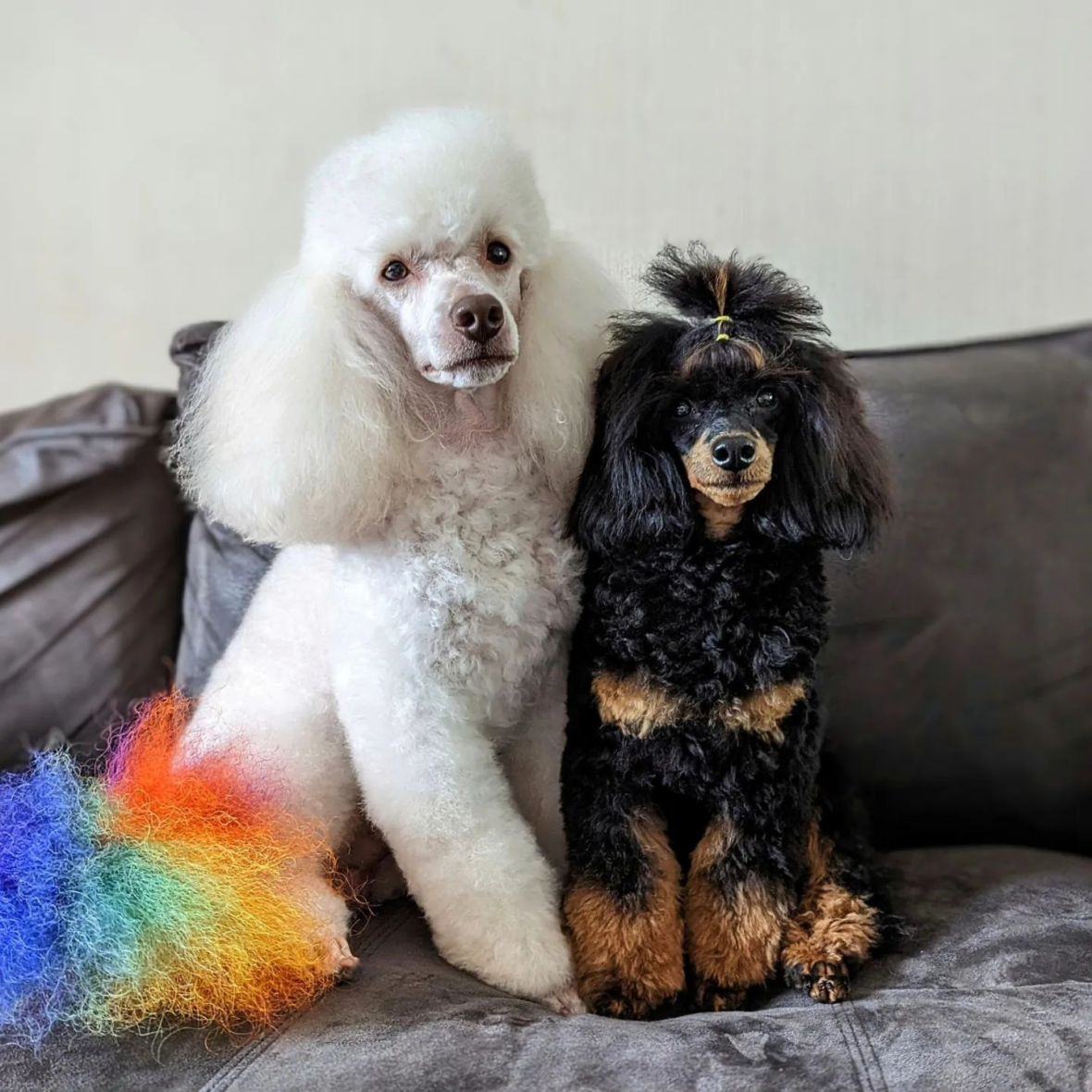A phantom toy poodle is not your average small companion dog. With their distinctive and striking coat pattern, these dogs are sure to turn heads wherever they go. Did you know that the term “phantom” refers to the specific color pattern of their fur? It’s a unique combination of one solid base color and specific markings that create a stunning contrast. This rarity makes phantom toy poodles highly sought after by dog enthusiasts and breeders alike.
Originating from France, phantom toy poodles have a rich history that dates back several centuries. These elegant dogs were originally bred as companions for French aristocracy, known for their intelligence, agility, and affectionate nature. Today, they continue to be valued as loyal and loving pets, bringing joy and companionship to their owners. In addition to their endearing personality traits, phantom toy poodles are also known for their hypoallergenic coats, making them a wonderful option for individuals with allergies. It’s no wonder they have become a popular choice for families and individuals seeking a small, stylish, and hypoallergenic canine companion.
A phantom toy poodle is a specific color pattern found in toy poodles. These dogs have a solid base color with defined markings in a second color, giving them a unique and striking appearance. The phantom markings typically appear on the face, ears, legs, and tail. Phantom toy poodles are highly sought after due to their beautiful coat patterns and charming personalities. They make wonderful companions and are known for their intelligence and trainability.

The Enigma of the Phantom Toy Poodle
Phantom Toy Poodles have a mystique that sets them apart from other poodle varieties. With their unique coat coloring and charming personalities, they have become a popular choice for dog lovers seeking a special companion. But what exactly is a Phantom Toy Poodle? In this article, we will delve into the characteristics, origins, temperament, and care of these captivating dogs, shedding light on the enigma that is the Phantom Toy Poodle.
Let us embark on our journey to uncover the secrets of this fascinating breed!
What is a Phantom Toy Poodle?
The Phantom Toy Poodle is a specific color variation of the Toy Poodle breed. Known for their distinctive coat pattern, Phantoms have a solid base color with sharply defined markings in a second color. These markings usually appear on the face, legs, chest, and under the tail. The base color can be anything from cream, silver, and apricot to black, while the markings are always a shade of tan or brown.
Phantom Toy Poodles are recognized by various kennel clubs and breed organizations, such as the American Kennel Club (AKC) and the United Kennel Club (UKC), under the general breed standard for Toy Poodles. However, the Phantom color pattern is considered a non-standard color and is not eligible for participation in conformation shows. Despite this, Phantoms have gained a loyal following and are beloved for their captivating appearance.
Now that we have a basic understanding of what defines a Phantom Toy Poodle, let us explore their history and origins.
The Origins of Phantom Toy Poodles
The exact origins of the Phantom Toy Poodle are not well-documented, but it is believed that they share a common ancestry with other varieties of the Toy Poodle breed. The Toy Poodle itself is descended from the larger Standard Poodle, which was originally bred as a water retriever in Germany.
As the popularity of the Poodle breed grew, breeders began experimenting with different coat colors and patterns. The Phantom color pattern emerged as a result of planned breeding between Poodles with specific coat colors and markings. Over time, this distinct coloration became sought-after by enthusiasts who were captivated by the unique beauty of the Phantom Toy Poodles.
Today, Phantom Toy Poodles can be found in homes across the world, bringing joy and companionship to their owners.
Temperament and Personality
Phantom Toy Poodles are known for their friendly, intelligent, and affectionate nature. They tend to be lively, playful, and eager to please their owners. These dogs thrive on human companionship and are highly trainable, excelling in obedience and agility activities.
While each individual dog has their own unique personality, Phantom Toy Poodles are generally good with children and other pets if properly socialized from a young age. They are alert and make excellent watchdogs, using their keen senses to alert their owners of any potential threats. Despite their small size, Phantoms have a big-hearted nature and love to be the center of attention in their families.
It is important to note that like all dogs, temperament can vary based on factors such as genetics, socialization, and training. Proper training and socialization from an early age are crucial in shaping the temperament and behavior of a Phantom Toy Poodle.
Caring for a Phantom Toy Poodle
Caring for a Phantom Toy Poodle involves providing them with proper nutrition, regular exercise, grooming, and veterinary care. Here are some key aspects to consider:
1. Nutrition
Feed your Phantom Toy Poodle a balanced diet formulated for small breeds. High-quality dry or wet dog food, supplemented with occasional treats, should meet their nutritional needs. Consult with your veterinarian for specific dietary recommendations based on your dog’s age, size, and activity level.
2. Exercise
Phantom Toy Poodles are an active and energetic breed, despite their small size. Regular exercise, such as daily walks, playtime in a securely fenced yard, and interactive toys, will help keep them physically and mentally stimulated. Be mindful not to overexert them, as their small size makes them more prone to injuries.
3. Grooming
Phantom Toy Poodles have a curly, dense coat that requires regular grooming to keep it in good condition. Brushing their coat a few times a week helps prevent tangles and mats. They may also need regular professional grooming to maintain their coat’s shape and cleanliness. Don’t forget to trim their nails, clean their ears, and brush their teeth regularly to promote good hygiene.
4. Veterinary Care
Regular veterinary check-ups, vaccinations, and preventive treatments for fleas, ticks, and internal parasites are essential for the health and well-being of your Phantom Toy Poodle. Your veterinarian can also provide guidance on spaying/neutering, dental care, and any breed-specific health concerns.
Is a Phantom Toy Poodle Right for You?
Now that you have explored the world of the Phantom Toy Poodle, you may be wondering if this breed is the right fit for your lifestyle and family. Here are a few key points to consider:
1. Size and Space
Phantom Toy Poodles are small dogs, typically weighing between 4 and 6 pounds. They can adapt well to apartment living and do not require a large yard. However, they still need regular exercise and mental stimulation.
2. Time and Commitment
Phantom Toy Poodles thrive on human companionship and require daily interaction and attention. They are not well-suited for households where they will be left alone for long periods. Consider your availability and ability to provide the time and commitment necessary for their care.
3. Allergies
Poodles, including Phantom Toy Poodles, are known for their hypoallergenic coat. While no dog is completely hypoallergenic, they produce less dander and shed less, making them suitable for people with allergies.
4. Training and Socialization
Phantom Toy Poodles are intelligent and trainable but require consistent positive reinforcement training and early socialization. If you are willing to invest time and effort into their training, they can be wonderful, well-behaved companions.
Ultimately, the decision to bring a Phantom Toy Poodle into your life should be based on careful research and consideration of your lifestyle, ability to meet their needs, and willingness to provide a loving and caring home.
Comparing Phantom Toy Poodle Colors
| Coat Color | Markings |
|---|---|
| Black Phantom | Tan or brown markings |
| Blue Phantom | Tan or brown markings |
| Red Phantom | Tan or brown markings |
| Apricot Phantom | Tan or brown markings |
| Chocolate Phantom | Tan or brown markings |
| Cream Phantom | Tan or brown markings |
Key Takeaways: “What is a Phantom Toy Poodle?”
- A phantom toy poodle is a specific color pattern found in poodles, characterized by a solid base color with markings in a secondary color.
- These markings appear similar to those of a Rottweiler, with the secondary color marking on the muzzle, eyebrows, legs, and under the tail.
- Phantom toy poodles are recognized by certain kennel clubs and can participate in conformation shows and other dog sports.
- The primary base colors for phantom toy poodles are black, brown, red, or silver, with the secondary color usually being a lighter shade.
- Phantom toy poodles are known for their intelligence, elegance, and hypoallergenic coats, making them popular pets for many families.
Frequently Asked Questions
The following are common questions and answers related to phantom toy poodles:
1. What is the size of a phantom toy poodle?
Phantom toy poodles are small-sized dogs, typically weighing between 4 to 6 pounds. They are considered a toy breed of poodle, known for their compact and delicate build.
Their small size makes them suitable for apartment living and they can easily be carried or transported. Despite their small stature, they are still sturdy and agile.
2. What are the distinguishing characteristics of a phantom toy poodle’s coat?
A phantom toy poodle has a unique coat pattern characterized by two colors. The primary color is usually a solid base color, such as black, chocolate, red, or apricot. This base color is accented by markings of a secondary color, typically tan or cream.
The markings on their coat appear on specific areas, such as the face, legs, chest, and tail. The distribution and intensity of these markings can vary, creating various patterns and combinations.
3. What is the temperament of a phantom toy poodle?
Phantom toy poodles are known for their intelligent and lively nature. They are social dogs that enjoy being around people and other pets. They are generally friendly, affectionate, and eager to please.
Despite their small size, they can be quite confident and have a moderate energy level. They require regular physical and mental stimulation to prevent boredom and destructive behaviors.
4. How do I care for a phantom toy poodle’s coat?
Maintaining the coat of a phantom toy poodle requires regular grooming. Brushing their coat frequently helps prevent matting and keeps their fur in good condition.
Professional grooming, including trimming and shaping, may be necessary every 4 to 6 weeks to maintain the desired appearance. Regular bathing and ear cleaning are also important for their overall hygiene.
5. Are phantom toy poodles suitable for families with children?
Phantom toy poodles can make great family pets, including families with children. However, it is important to supervise interactions between young children and the dog to ensure safety and teach proper handling.
Early socialization and training are crucial to ensure they develop good manners and get along well with children and other pets. With the right care and guidance, phantom toy poodles can be loving and devoted companions for the whole family.

A phantom toy poodle is a unique color variation of the toy poodle breed. It has a specific coat pattern that includes a base color with distinct markings.
The coat of a phantom toy poodle typically has a solid base color, such as black, brown, or gray, with contrasting markings in specific areas. These markings can appear on the eyebrows, muzzle, chest, legs, and tail. The contrast between the base color and markings gives the phantom toy poodle a striking and distinctive appearance.
